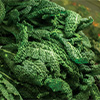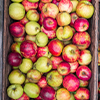
Featured Produce | Winter Quarterly 2020
Featured Produce
Winter is the time of the hardy vegetable, and leeks stand tall in the crowd.
Whether you’re slicing some up for soup or serving with your favorite seafoods, leeks can add a delicious, mild flavor to your winter dishes.
Fresh Facts
• Leeks were first cultivated in Egypt before being brought over to Europe by the Romans.
• As a member of the Allium genus, leeks are closely related to onions, shallots, scallions, chives and garlic.
• Leeks can often substitute onions in a recipe due to their similar, yet milder and sweeter taste. Substituting onions for leeks, however, can leave you with too strong of a flavor for your recipe.
• There are two categories of leeks: Short-season
leeks planted in spring for late summer harvest that tend to be smaller with a milder flavor, and overwintering leeks grown for much longer that are hardier and stronger in flavor.
• The stalk of a fresh leek is straight but begins to round and become more bulb-like as leeks mature. The more round the bulb, the more mature the leek.
• Leeks can be stored in a refrigerator for about a week, depending on how fresh they are upon purchasing. Freezing will cause leeks to break down and increase in bitterness. Once cooked, leeks have a shelf-life of about two days.
• The main edible portion of a leek is the lower, white area of the stock, which is a result of blanching. Blanching is the process of preventing sunlight from reaching specific parts of a growing plant using various methods, such as hilling up soil around stems or growing plants in trenches and filling with soil.




